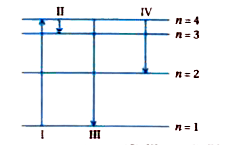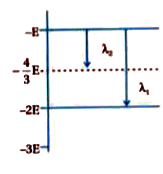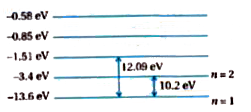Complete Solutions to Section-D (MCQs asked in Competitive Exams) (MCQs asked in AIEEE and JEE (Main)) of chapter ATOMS of Class 12 book with complete answers and questions
| Class 12 | PHYSICS |
| Chapter | ATOMS |
| KUMAR PRAKASHAN | Section-D (MCQs asked in Competitive Exams) (MCQs asked in AIEEE and JEE (Main)) |
| Number Of Questions | 50 |
| Academic Year | 2023-24 |
If 13.6 eV energy is required to ionize the hydrogen atom, then the energy required to remove an electron from
View SolutionThe wavelength involved in the spectrum of deuterium `(._(1)^(2)D)` are slightly different from that of hydrogen spectrum because
View SolutionIf the binding energy of the electron in a hydrogen atom is 13.6 eV, the energy required to remove the electron from the first excited state `Li^(+2)` is .......
View SolutionAn `alpha` particle of energy 5 MeV is scattered through `180^(@)` by a fixed uranium nucleus. The distance of the closest approach is of the order of ........
View SolutionAn another point charge q, thrown towards the stationary point charge Q at speed v, it returns at a distance r from Q. If 2v speed is given instead of v then distance of closest approach will be ………
View SolutionThe diagram shows the energy levels for an electron in a certain atom. Which transition shown represent the emission of a photon with the most energy ?

View SolutionAn `alpha`-nucleus of energy `(1)/(2)mv^(2)` bombards a heavy nuclear target of charge Ze. Then the distance of closest approach for the O-nucleus will be proportional to ......
View SolutionWhich of the following transitions in hydrogen atoms emit photons of highest frequency?
View SolutionSuppose an electron is attracted towards the origin by a force `(k)/(r )` where k is a constant and r is the distance of the electron from the origin. By applying Bohr model to this system, the radius of the `n^(th)` orbital of the electron is found to be `r_(n)` and the kinetic energy of the electron to be `T_(n)`. Then which of the following is true?
View SolutionThe transistion from the state `n = 4` to `n = 3` in a hydrogen like atom results in ultraviolet radiation infrared radiation will be obtained in the transition from :-
View SolutionThe energy required for electron to transist from n = 1 to n = 3 in `Li^(+2)` is ......
View SolutionHydrogen atom is excited from ground state to another state with principle quantum number equal to 4. Then the number of spectral lines in the emission spectra will be ......
View SolutionThe ionisation potential for ...... nucleus will be minimum.
View SolutionIn a hydrogen like atom electron makes transition from an energy level with quantum number n to another with quantum number `(n-1)`. If `ngtgt1`, The frequency of radiation emitted is proportional to
View SolutionThe radiation corresponding to `3 to 2` transition of hydrogen atom falls on a metal surface to produce photoelectrons.These electrons are made to enter a magnetic field of `3xx10^(-4)`T.If the radius of the largest circular path followed by these electrons is 10.0 mm the work function of the metal is close to:
View SolutionHydrogen `(""_(1)H^(1))`, Deuterium `(""_(1)H^(2))`, single ionised Helium `(""_(2)He^(4))^(+)` and doubly ionised lithium `(""_(3)Li^(6))^(++)` all have one electron around the nucleus. Consider an electron transition from n=2 to n=1. If the wavelength of emitted radiation are `lamda_(1),lamda_(2),lamda_(3)` and `lamda_(4)` respectively then approximately which one of the following is corrent ?
View SolutionDia-atomic molecule is composed of masses `m_(1)` and `m_(2)` and distance between them is r. By using the principle of quantisation of angular momentem of Bohr its energy of rotation is given by the formula ....... [Where n is integer and `h=(h)/(2pi)` ]
View SolutionAs an electron makes a transition from an excited state to the ground state of a hydrogen like atom/ion.
View SolutionSome energy levels of a molecule are shown the figure. The ratio of the wavelength `r=(lamda_(1))/(lamda_(2))` is given by …………..

View SolutionAn electron from various excited states of hydrogen atom emit radiation to come to the ground state. Let `lamda_(n),lamda_(g)` be the de Broglie wavelength of the electron in the `n^(th)` state and the ground state respectively. Let `A_(n)` be the wavelength of the emitted photon in the transition from the `n^(th)` state to the ground state. For large n, (A, B are constant)
View SolutionIf the series limit frequency of the Lyman series is `v_(L)`, then the series limit frequency of the Pfund series is ......
View SolutionThe time period of revolution of an electron in its ground state orbit in a hydrogen atom is `1.6xx10^(-16)` s. The frequency of the electron in its first excited state (in `s^(-1)` ) is :
View SolutionNumber of the a-particle deflected in Rutherford's a-particle scattering experiment varies with the angle of deflection. The graph between the two is best represented by
View SolutionThe ionisation energy of hydrogen atom is 13.6 eV, the ionisation energy of a singly ionised helium atom would be ......
View SolutionTo explain his theory, Bohr used………
View SolutionIn terms of Bohr radius a, the radius of the second Bohr orbit of a hydrogen atom is given by …………
View SolutionThe radius of hydrogen atom in its ground state is `5.3xx10^(-11)`m. After collision with an electron it is found to have a radius `21.2xx10^(-11)` m, then principle quantum number n of the final state of the atom ......
View SolutionJ.J.Thomson's cathode ray tube experiment demonstrated that ......
View SolutionIn which of the following system will the radius of the first orbit (n = 1) be minimum ?
View SolutionThe Bohr model of atom ......
View SolutionEnergy of a hydrogen atom with principal quantum number n is shown by `E = (-13.6)/(n^(2)) eV`. The energy of a photon ejected when the electron jumps from n = 3 state to n = 2 state of hydrogen is approximately.
View SolutionThe total energy of an electron in the first excited state of the hydrogen atom is about –3.4 eV.
(a) What is the kinetic energy of the electron in this state?
(b) What is the potential energy of the electron in this state?
(c) Which of the answers above would change if the choice of the zero of potential energy is changed?
View SolutionIonization potential of hydrogen atom is 13.6 eV. Hydrogen atoms in the ground state are excited by monochromatic radiation of photon energy 12.1 eV. According to Bohr's theory, the spectral lines emitted by hydrogen will be ......
View SolutionThe ground state energy of hydrogen atom is - 13.6 eV. When electron is in excited state its excitation energy is ......
View SolutionThe ionization energy of the electron in the hydrogen atom in its ground state is 13.6 eV. The atoms are excited to higher energy levels to emit radiation of 6 wavelengths. During which of the following transitions will the maximum wavelength radiation be emitted ?
View SolutionIn a Rutherford's scattering experiment when a projectile of chargez `Z_(1)`and mass `M_(1)` approaches a target nucleus of `Z_(2)` and mass `M_(2)` the distance of closest approach is `r_(0)`. The energy of the projectile is........
View SolutionThe energy of a hydrogen atom in the ground state is -13.6 eV. The energy of a He+ ion in the first excited state will be .....
View SolutionThe wavelength of the first line of Lyman series for hydrogen atom is equal to that of the second line of Balmer series for a hydrogen like ion. The atomic number Z of hydrogen like ion is .........
View SolutionOut of the following which one is not a possible energy for photon to be emitted by hydrogen atom according to Bohr's atomic model?

View SolutionAn electron in the hydrogen atom jumps from excited state n to the ground state. The wavelength so emitted illuminates a photo sensitive metal having work function 2.75 eV. If the stopping potential of the photoelectron is 10 V, the value of n is ...
View SolutionThe ratio of maximum wavelength of Lyman and Balmer series in hydrogen emission spectra will be ......
View SolutionHydrogen atom in ground state is excited by a monochromatic radiation of wavelength `lambda = 975 Å` then number of spectral lines in resulting spectrum emitted will be ......
View SolutionConsider 3rd orbit of Het (Helium), using non-relativistic approach, the speed of electron in this orbit will be given `k = 9 xx 10^(9)` constant, Z = 2 and h(Planck's Constant) = `6.6xx10^(-34)JK)`
View SolutionGiven the value of Rydberg constant is `10^(7) m^(-1)` the wave number of the last line of the Balmer series in hydrogen spectrum will be
View SolutionWhen an o-particle of mass m moving with velocity v bombards on a heavy nucleus of charge 'Ze', its distance of closest approach from the nucleus depends on m as
View SolutionIf an electron in a hydrogen atom jumps from the 3rd orbit to the 2nd orbit, it emits a photon of wavelength `lambda`. When it jumps from the `4^(th)` orbit to the `3^(rd)` orbit, the corresponding wavelength of the photon will be
View SolutionIf the longest wavelength of the ultraviolet region of hydrogen spectrum is `lambda_(0)` then the shortest wavelength of its infrared region is ......
View SolutionThe ratio of wavelength of the last line of Balmer series and the last line of Lyman series is ....
View SolutionThe ratio of kinetic energy of the total energy of an electron of a Bohr orbit of the hydrogen atom is ......
View SolutionThe total energy of an electron in an atom in an orbit is -3.4 eV. Its kinetic and potential energies are, respectively:
View Solution
Section-D (MCQs asked in Competitive Exams) (MCQs asked in AIEEE and JEE (Main)) questions and complete solutions for chapter ATOMS of KUMAR PRAKASHAN KENDRA PHYSICS (GUJRATI ENGLISH) of Class 12
All Exercises from KUMAR PRAKASHAN Class 12 PHYSICS ATOMS
- NUMERICAL FROM DARPAN BASED ON TEXTBOOK
- SECTION-A (QUESTIONS- ANSWERS)
- SECTION-B (Additional Exercises)
- SECTION-B (Numerical From Textual Exercise)
- SECTION-B (NUMERICALS) (Numerical From Textual Illustrations)
- SECTION-C (NCERT EXEMPLAR SOLUTION) ( Long Answer Type Questions)
- SECTION-C (NCERT EXEMPLAR SOLUTION) ( Short Answer Type Questions)
- SECTION-C (NCERT EXEMPLAR SOLUTION) (Multiple Choice Questions (MCQs))
- SECTION-C (NCERT EXEMPLAR SOLUTION) (Multiple Choice Questions (More than One Options))
- SECTION-C (NCERT EXEMPLAR SOLUTION) (Very Short Answer Type Questions)
- Section-D (MCQs asked in Competitive Exams) (MCQs asked in AIEEE and JEE (Main))
- Section-D (Multiple Choice Questions (MCQs)) (MCQs From .DARPAN Based On Textbook)
- Section-D (Multiple Choice Questions (MCQs)) (MCQs From .DARPAN Based On Textbook) (Atomic Spectra)
- Section-D (Multiple Choice Questions (MCQs)) (MCQs From .DARPAN Based On Textbook) (Bohr Model of Hydrogen Atom )
- Section-D (Multiple Choice Questions (MCQs)) (MCQs From .DARPAN Based On Textbook) (de-Broglie.s Explanation of Bohr.s Second Postulate of Quantisation)
- Section-D (Multiple Choice Questions (MCQs)) (MCQs From .DARPAN Based On Textbook) (Line Spectrum of Hydrogen Atom)
- Section-D (Multiple Choice Questions (MCQs)) (MCQs From .DARPAN Based On Textbook) (MCQs based on Textual Illustrations and Exercise )
- Section-D -MCQs asked in AIIMS
- Section-D -MCQs asked in GUJCET / Board Exam
- TRY YOURSELF